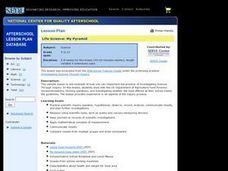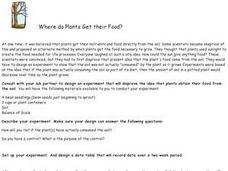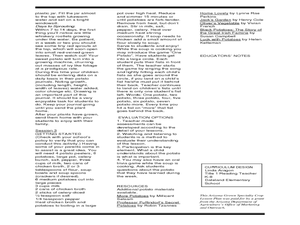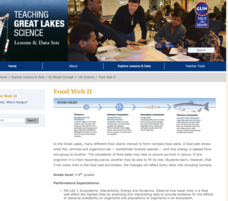Curated OER
Where are Koalas on the Food Chain?
Take a field trip to observe Koalas, absolutely! Budding scientists become familiar with the Koala's position in the food chain. They answer questions based on what they see and draw a food chain explaining the Koalas position. Tip: A...
Curated OER
Home Living / Daily Living: Labels on Food Products
Everybody needs to know how to make healthy choices when it comes to food. Understanding food labels is the first step. Using empty food packaging, you'll discuss what food labels are, what information can be found on them, and how to...
Curated OER
Life Science: My Pyramid
Students examine how the school food program compares to the food pyramid recommendations. In this food pyramid lesson, students compile data regarding the food choices available in the school through the lunch program and vending...
Curated OER
Where Do Plants Get Their Food?
Plants need food to survive, just like any other living organism. Young biologists analyze an experiment performed in 1610 by Jan van Helmont to determine if plant nutrition is obtained through the soil. First, lab groups work together...
University of California
You Are What You Eat: Testing for Organic Compounds in Foods
We have all heard that we are what you eat, but what are we eating? An informative lesson opens with a discussion of the foods pupils have recently eaten. Then, young scientists perform four experiments on seven different foods to...
Missouri Department of Elementary
Equine Science
Did you know that horses have two sets of teeth? There is much to learn about horses, of course, and those interested in equine science will learn much from a 10-lesson agricultural science course that covers not only equine dental and...
Baylor College
Energy for Life (Energy from Food)
Energy comes in many forms, but how do living things get the energy they need to survive and thrive? In a simple, controlled experiment with yeast, water, and sugar, groups make observations about how yeast reacts with water alone, then...
Curated OER
Good Food, Good Health
Young scholars investigate how food provides energy for the human body. In this physical health lesson, students access online resources to identify how certain foods can affect their health. Young scholars discuss how many servings of...
Curated OER
Exploring Living Science Careers
Use a variety of group activities to explore living science careers. Living science careers include everything from a food scientist or farmer to a veterinarian or agricultural economist. Kids will discuss 31 different careers in this...
Curated OER
What Are the Food Groups?
Students discover the four main food groups by categorizing their own diet. In this healthy eating instructional activity, students utilize a chart with pictures of food to identify which food belongs in which food group. Students...
Curated OER
Food Pyramid Abacus
Students investigate the Food Pyramid by constructing a creative project known as a Food Pyramid Abacus. They correlate the color beads withe each food group and the number of recommended servings from each. The abacus is a learning tool...
Curated OER
Nutrition 2: Good Food, Good Health
Students use internet resources research more about how eating good and bad food can affect their health. Students study the food pyramid and examine how important it is to eat from all food groups. Discussion questions are provided,...
Curated OER
Eating Right with a Little Help From the VT
Students explore the food pyramid. In this nutrition lesson, students identify the 5 food groups and sort foods according to the group in which they belong. Students use the Visual Thesaurus to complete a food groups worksheet and...
Curated OER
From Mashed to Riches
Students discuss the uses of a potato. In this food group lesson plan, students identify the five food groups and which one the potato belongs to. They create potato printing, compare different kinds of potatoes, grow a potato plant, and...
Channel Islands Film
Human Impact on the Food Web of Santa Cruz Island
What happens when a non-native species is introduced onto an island? Santa Cruz Island, part of the Channel Island chain located off the coast of southern California, provides the perfect laboratory for young environmental scientists to...
Curated OER
The Food Pyramid
Learning about nutrition and how to eat healthy foods is very important for kids these days. Here is a lesson, designed for 4th graders, that teaches these important skills. Pupils plan nutritional meals by using the USDA's Food Guide...
It's About Time
Who Eats Whom?
Packed with visual aids and multiple learning opportunities, an engaging exercise challenges individuals as they explore the role of producers, consumers, and decomposers. After discussing differences between food chains, food...
Towson University
The Crucial Concentration
Which sports drink provides the best pick-me-up after the big game or grueling workout? It may not be the one you'd think! Food science is the focus in a surprising lab activity. Pupils use colorimetry to determine the amount of protein,...
Science Matters
Peanut Energy
How do humans get energy since they aren't mechanical and can't photosynthesize? Learners explore this question by relating potential energy in food to human energy levels. Scholars measure the change in mass and a change in temperature...
NOAA
Animals of the Fire Ice
When the sun's rays can't reach the producers in a food web, where does all the energy come from? Extreme environments call for extreme food sources. Young scientists investigate creatures that appear to get their energy from methane...
Curated OER
Food Chain: what's for dinner?
Fourth graders identify where foods came from and sequence a food chain. In this food chain instructional activity, 4th graders define vocabulary related to food chains and order a food chain. Students follow the energy of a food chain....
Curated OER
Understanding My Pyramid
Learners investigate the food pyramid. In this nutrition instructional activity, students view and discuss the food pyramid and the role it plays in our diets. Learners develop a three dimensional model of the food pyramid and create a...
Michigan Sea Grant
Food Web II
A food web consists of complex food chains and the more complex the web, the better likelihood of survival. Learners compare and contrast food webs and food chains and discuss concepts like the predator-prey and consumer-producer...
Consortium for Ocean Science Exploration and Engagement (COSEE)
Arctic Smorgasbord
Though the walrus spends roughly one third of its time on land, it eats organisms that live on the bottom of the ocean. The first in a series of five, the lesson uses a variety of plant and animal cards to have scholars build an arctic...

























